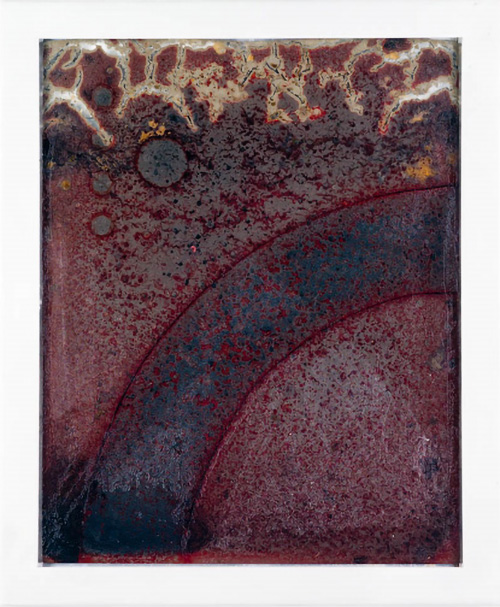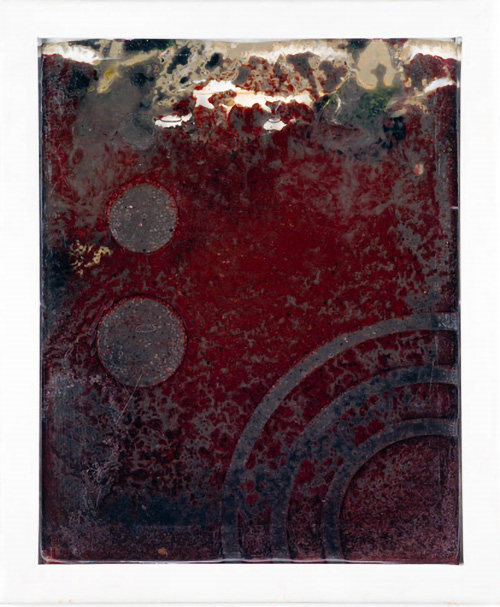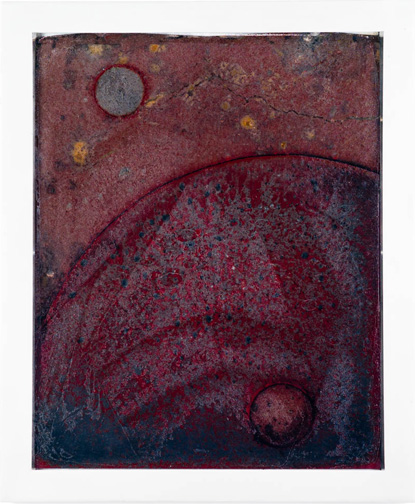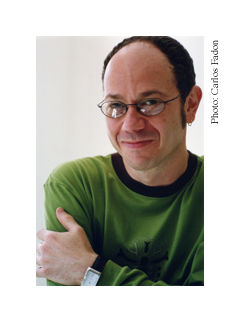Originally posted on sciy.org by Rich Carlson on Sun 28 Dec 2008 06:03 PM PST
EDUARDO KAC
Specimen of
Secrecy About Marvelous
Discoveries
Singapore
Biennale (4 September - 12 November
2006)
"Specimen of Secrecy about Marvelous Discoveries" is a series of works comprised of what Kac calls "biotopes", that is, living pieces that change during the exhibition in response to internal metabolism and environmental conditions. Each of Kac’s biotopes is literally a self-sustaining ecology comprised of thousands of very small living beings in a medium of earth, water, and other materials. The artist orchestrates the metabolism of these organisms in order to produce his constantly-evolving living works.
Kac's biotopes expand on ecological and evolutionary issues previously explored by the artist (for example, in his transgenic work "The Eighth Day"). At the same time, the biotopes further develop dialogical principles implemented and theorized by Kac for approximately two decades.
The biotopes are a discrete ecology because within their world the microorganisms interact with and support each other (that is, the activities of one organism enable another to grow, and vice-versa). However, they are not entirely secluded from the outside world : the aerobic organisms within the biotope absorb oxygen from outside (while the anaerobic ones comfortably migrate to regions where air cannot reach). A complex set of relationships emerge as the work unfolds, bringing together the internal dialogical interactions among the microorganisms in the biotope and the interaction of the biotope as a discrete unit with the external world. The biotope is affected by several factors, including the very presence of viewers, which can increase the temperature in the room (warm bodies) and release other microorganisms in the air (breathing, sneezing).
The biotope is what Kac calls a "nomad ecology", that is, an ecological system that interacts with its surroundings as it travels around the world. Every time a biotope migrates from one location to another, the very act of transporting it causes an unpredictable redistribution of the microorganisms inside it (due to the constant physical agitation inherent in the course of a trip). Once in place, the biotope self-regulates with internal migrations, metabolic exchanges, and material settling.
When the viewer looks at a biotope, she sees what could be described as an "image". However, since this "image" is always already evolving into its next transformative state, the perceived "stillness" is more a consequence of the conditions of observation (limits of human perception, ephemeral presence of the viewer in the gallery) than an internal material property of the biotope. Viewers looking at the biotope the next day will see a different "image". Given the cyclical nature of this "image", each "image" seen on a given day is but a moment in the evolution of the work, an ephemeral snapshot of the biotope metabolic state, a scopic interface for human intimacy.
Each of Kac’s “biotopes†has a cycle, which starts when the artist produces the self-contained world by integrating microorganisms and nutrient-rich media. In the next step, Kac controls the amount of energy the microorganisms receive in order to keep some of them active and others in suspended animation. This results in what the viewer may momentarily perceive as a still image. However, even if the image seems "still" the work is constantly evolving and is never physically the same. Only time lapse video can reveal the transformation undergone by a given biotope in the course of its slow change and evolution. Once an exhibition begins, in the third phase of the cycle the artist allows the microorganisms in suspended animation to become active again. The work becomes progressively different, changing every day, every week, every month. This process continuously transforms the image and may, depending of factors such as lighting conditions and exhibition length, result in its effacement — until the cycle begins again.
Eduardo Kac calls these works "biotopes" because they are literally an ecological community of diverse microbial life. The populations within Kac's biotopes recycle nutrients and essentially support themselves. At the Singapore Biennale Kac is presenting six “biotopesâ€, each measuring 19 x 23 inches.
The works start to change in response to environmental circumstances, including temperature, relative humidity, airflow, and light levels in the exhibition space. During the Biennale, both the colors of the works and the living images transform themselves -- a reminder of life’s "sensitive dependence on initial conditions".
Clairvoyance

| Apsides |

Hallaballoo

Oblivion

Odyssey
EDUARDO KAC -- BIOGRAPHICAL NOTE

Eduardo Kac is internationally recognized for his interactive net installations and his bio art. A pioneer of telecommunications art in the pre-Web '80s, Eduardo Kac (pronounced "Katz") emerged in the early '90s with his radical telepresence and biotelematic works. His visionary combination of robotics and networking explores the fluidity of subject positions in the post-digital world. His work deals with issues that range from the mythopoetics of online experience (Uirapuru) to the cultural impact of biotechnology (Genesis); from the changing condition of memory in the digital age (Time Capsule) to distributed collective agency (Teleporting an Unknown State); from the problematic notion of the "exotic" (Rara Avis) to the creation of life and evolution (GFP Bunny).
At the dawn of the twenty-first century Kac opened a new direction for contemporary art with his "transgenic art"--first with a groundbreaking net installation entitled Genesis (1999), which included an "artist's gene" he invented, and then with his fluorescent rabbit called Alba (2000).
From his first experiments online in 1985 to his current convergence of the digital and the biological, Kac has always investigated the philosophical and political dimensions of communication processes. Equally concerned with the aesthetic and the social aspects of verbal and non-verbal interaction, in his work Kac examines linguistic systems, dialogic exchanges, and interspecies communication. Kac's pieces, which often link virtual and physical spaces, propose alternative ways of understanding the role of communication phenomena in creating shared realities.
Kac merges multiple media and biological processes to create hybrids from the conventional operations of existing communications systems. Kac first employed telerobotics in 1986 motivated by a desire to convert electronic space from a medium of representation to a medium for remote agency. He creates pieces in which actions carried out by Internet participants have direct physical manifestation in a remote gallery space. Often relying on the indefinite suspension of closure and the intervention of the participant, his work encourages dialogical interaction and confronts complex issues concerning identity, agency, responsibility, and the very possibility of communication.
Kac’s work has been exhibited internationally at venues such as Exit Art and Ronald Feldman Fine Arts, New York; Maison Européenne de la Photographie, Paris, and Lieu Unique, Nantes, France; OK Contemporary Art Center, Linz, Austria; InterCommunication Center (ICC), Tokyo; Julia Friedman Gallery, Chicago; Seoul Museum of Art, Korea; and Museum of Modern Art, Rio de Janeiro. Kac's work has been showcased in biennials such as Yokohama Triennial, Japan, Bienal de Sao Paulo, Brazil, and Gwangju Biennale, Korea. His work is part of the permanent collection of the Museum of Modern Art in New York, the ZKM Museum, Karlsruhe, Germany, and the Museum of Modern Art in Rio de Janeiro, among others. He is currently working on a public art commission for the University of Minnesota, which will be on the permanent collection of the Weisman Art Museum, Minneapolis.
Kac's work has been featured both in contemporary art publications (Flash Art, Artforum, ARTnews, Kunstforum, Tema Celeste, Artpress, NY Arts Magazine) and in the mass media (ABC, BBC, PBS, Le Monde, Boston Globe, Washington Post, Chicago Tribune, New York Times). The recipient of many awards, Kac lectures and publishes worlwide. His work is documented on the Web in eight languages: https://www.ekac.org.
Kac is a member of the editorial board of the journal Leonardo, published by MIT Press. Kac's writings on art, which have appeared in several books and periodicals in many countries, have been collected in two volumes: Telepresence and Bio Art : Networking Humans, Rabbits and Robots (Ann Arbor: University of Michigan Press, 2005) and Luz & Letra (Rio de Janeiro: Contra Capa, 2004). Kac's poetry is collected in Hodibis Potax (Édition Action Poétique, Ivry-sur-Seine (France) and Kibla, Maribor (Slovenia), 2007). Books about Kac's work include: Eduardo Kac : Move 36, Elena Giulia Rossi, editor (Paris : Filigranes Éditions, 2005), The Eighth Day: The Transgenic Art of Eduardo Kac, Sheilah Britton and Dan Collins, eds. (Tempe: ISA/ASU -- New York: DAP, 2003) and Eduardo Kac (Valencia: IVAM, 2007).
Eduardo
Kac is represented by Fringe Exhibitions, Los Angeles, Black Box
Gallery, Copenhagen and Laura Marsiaj Arte Contemporânea, Rio de
Janeiro.
Attachment:







